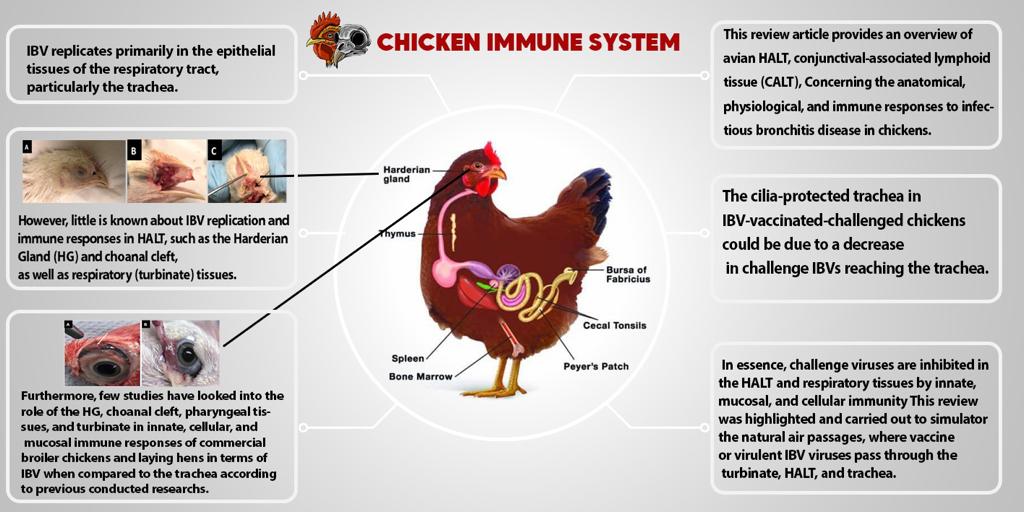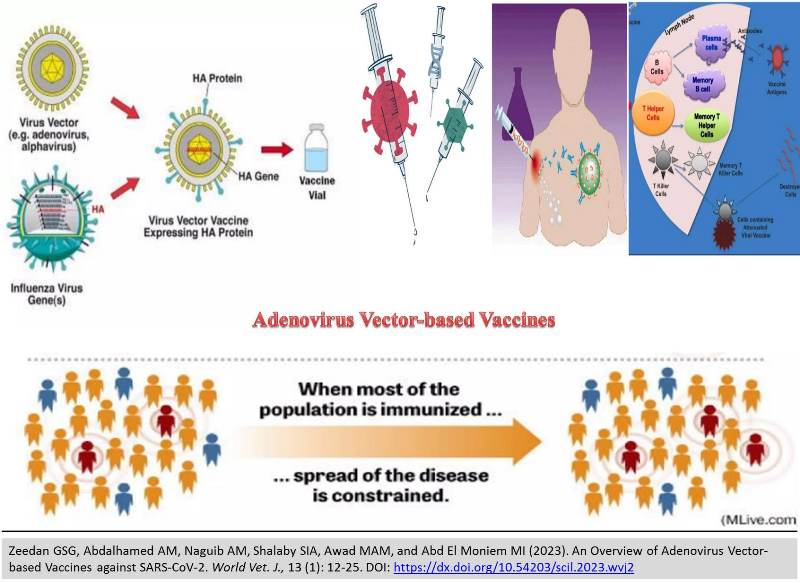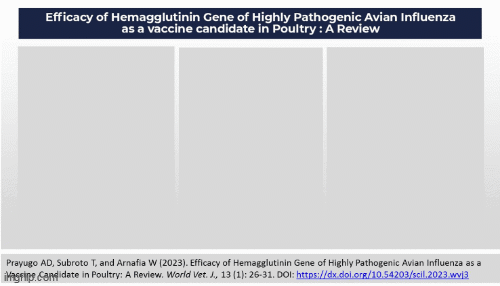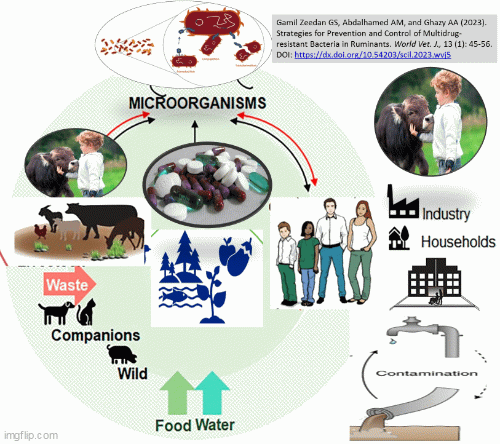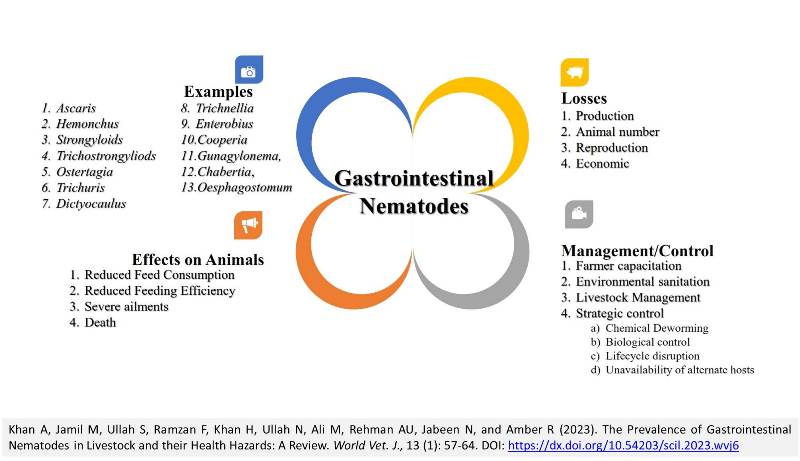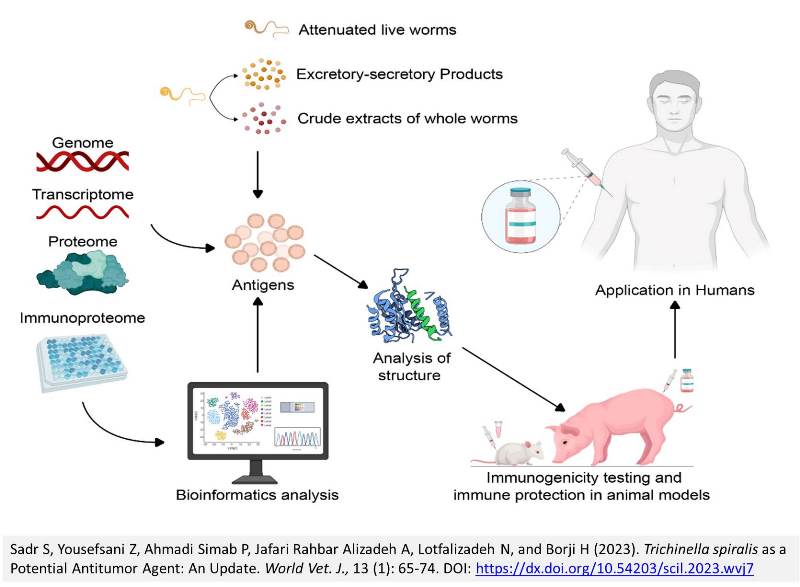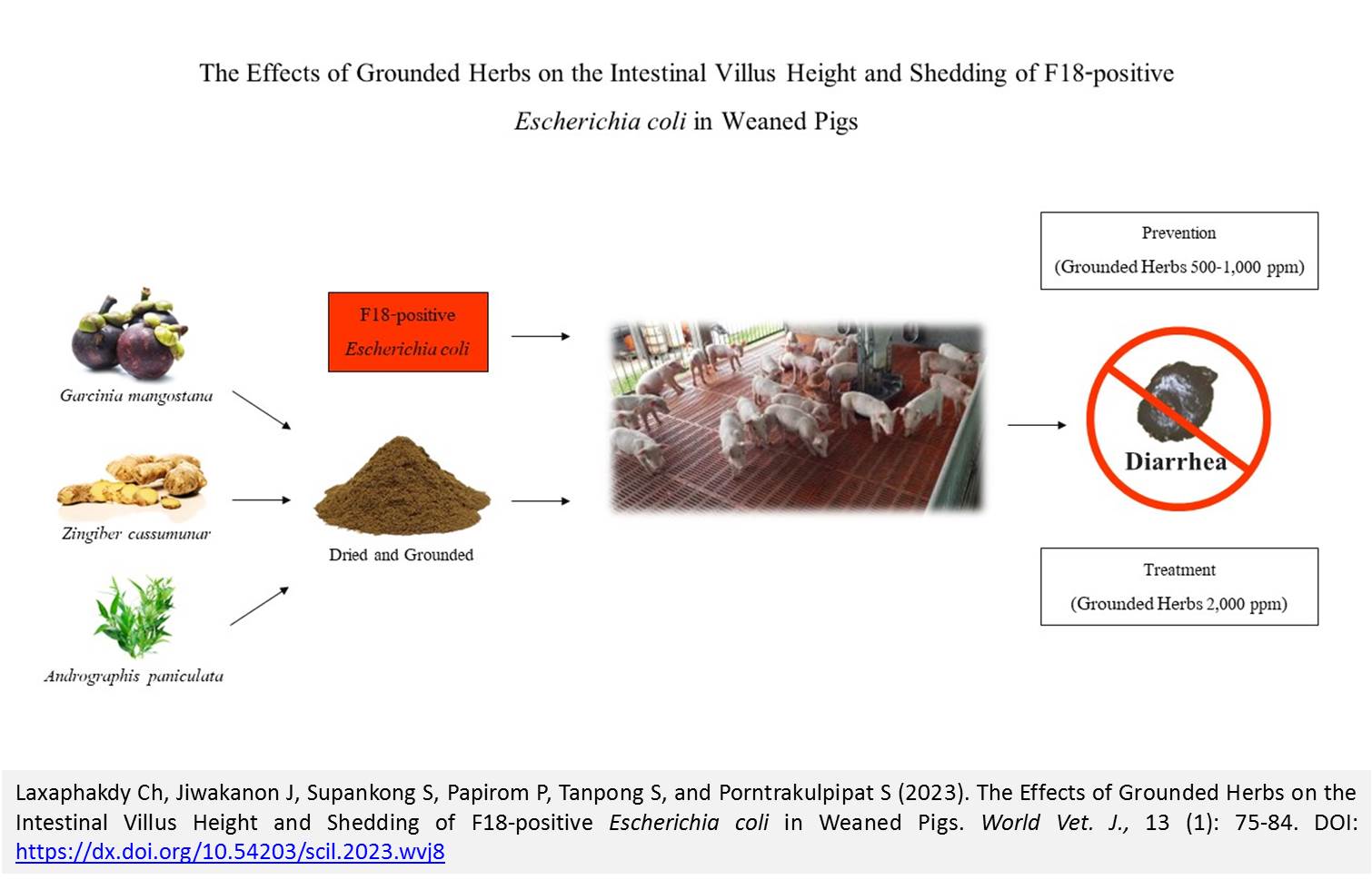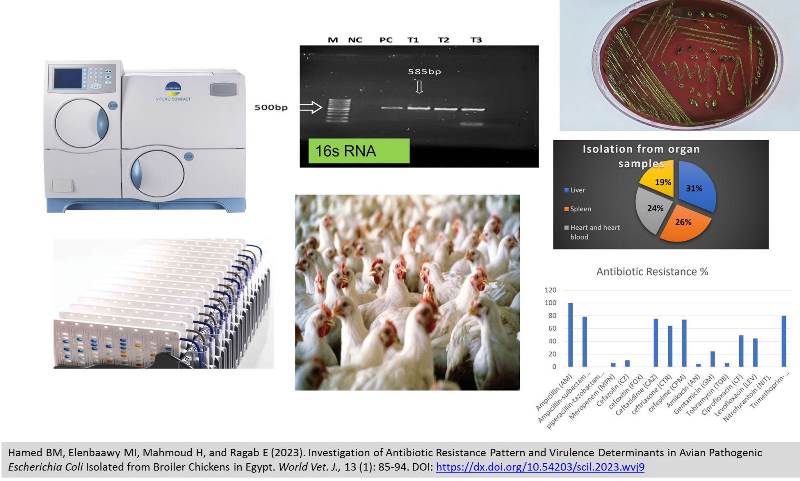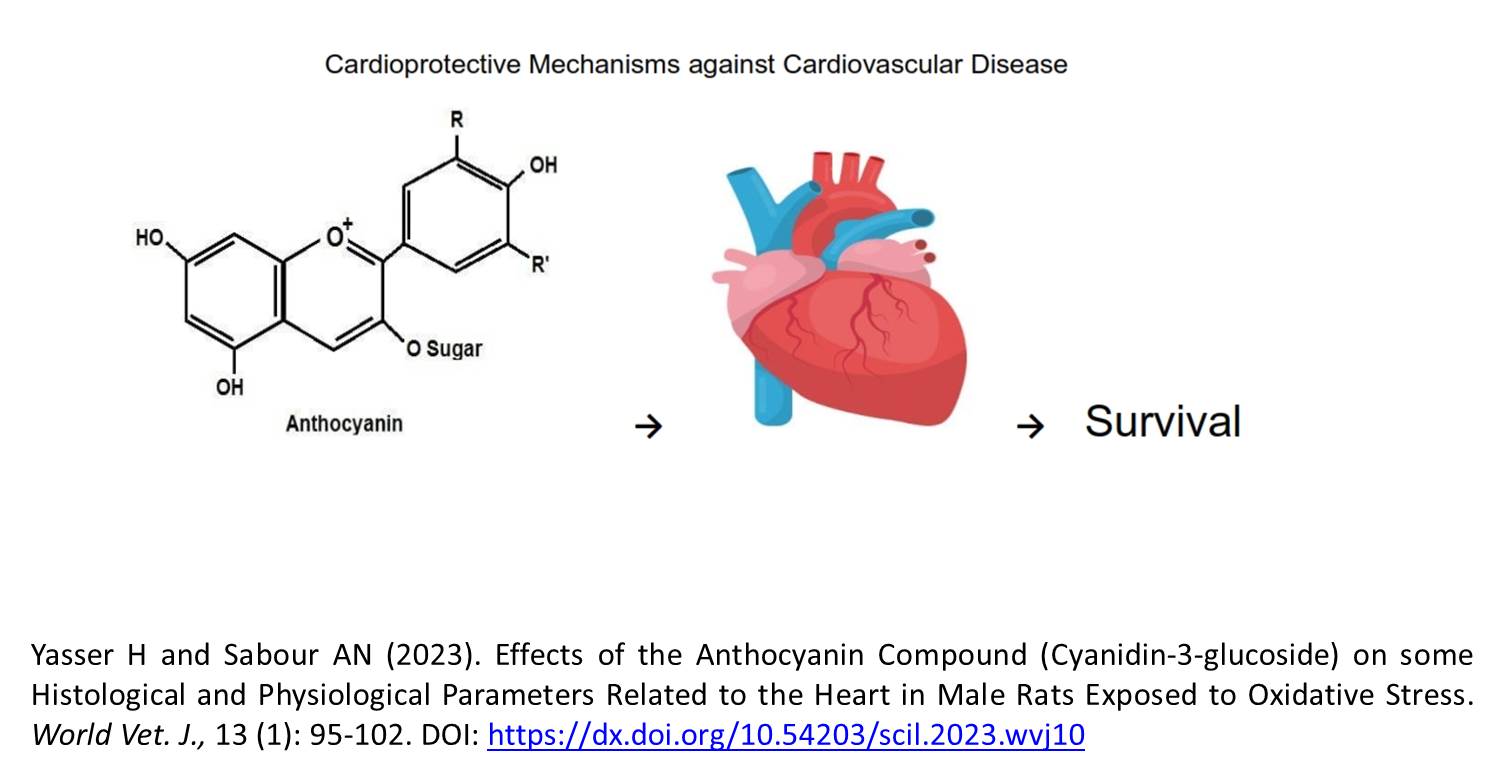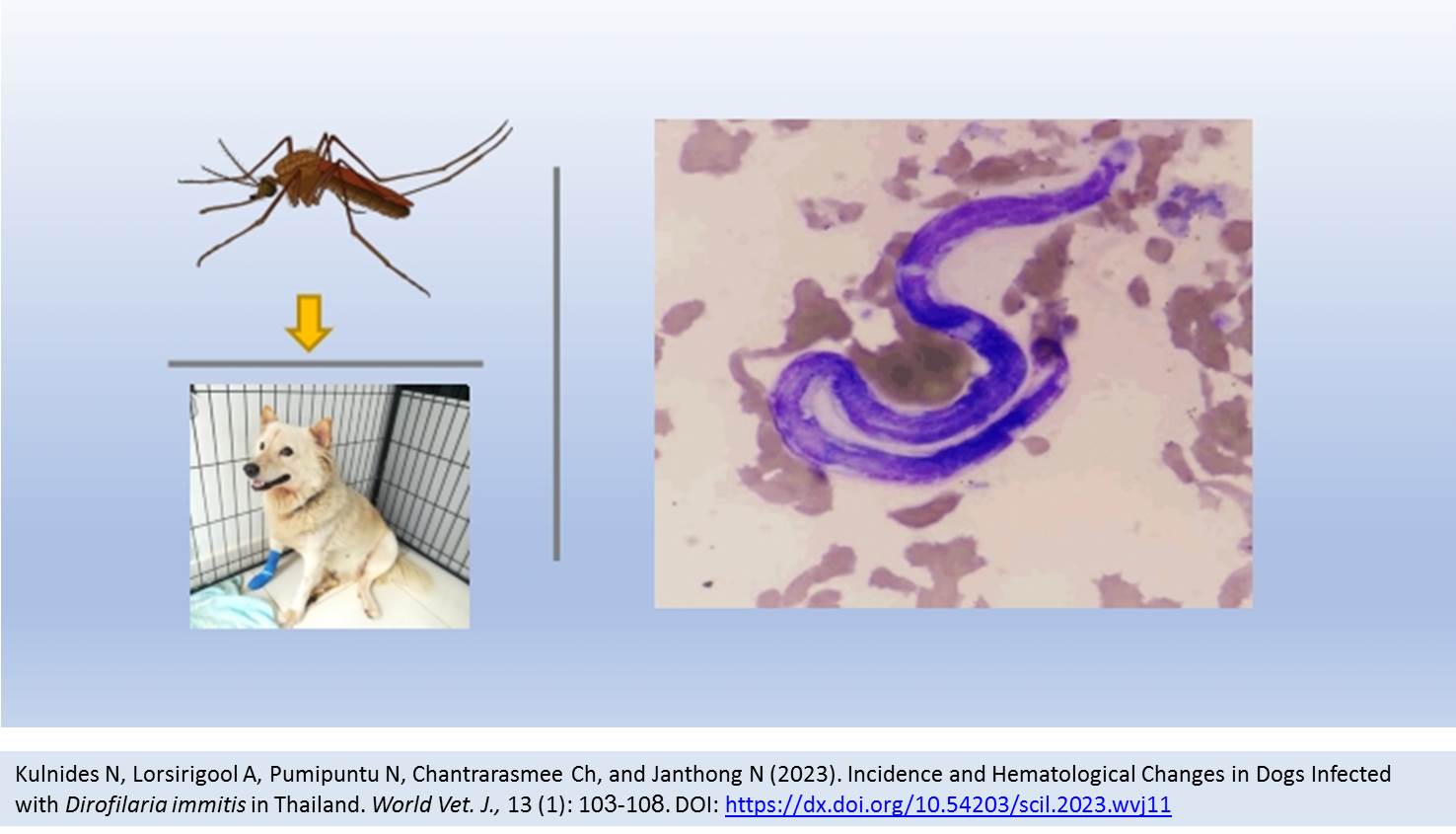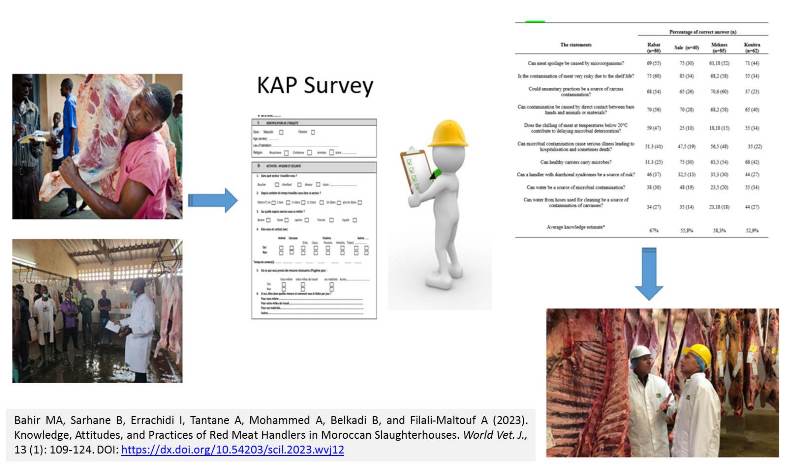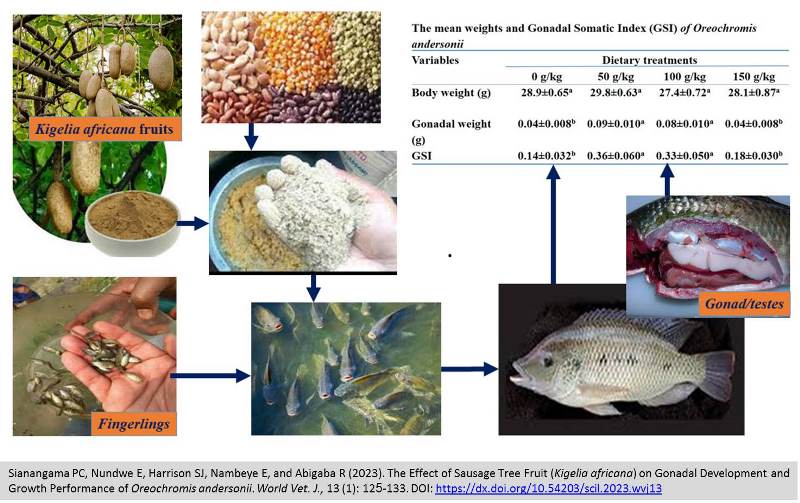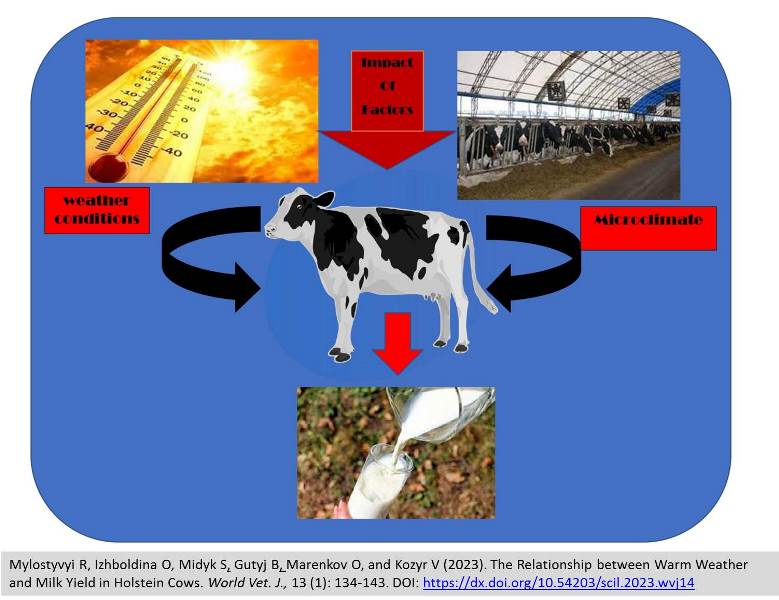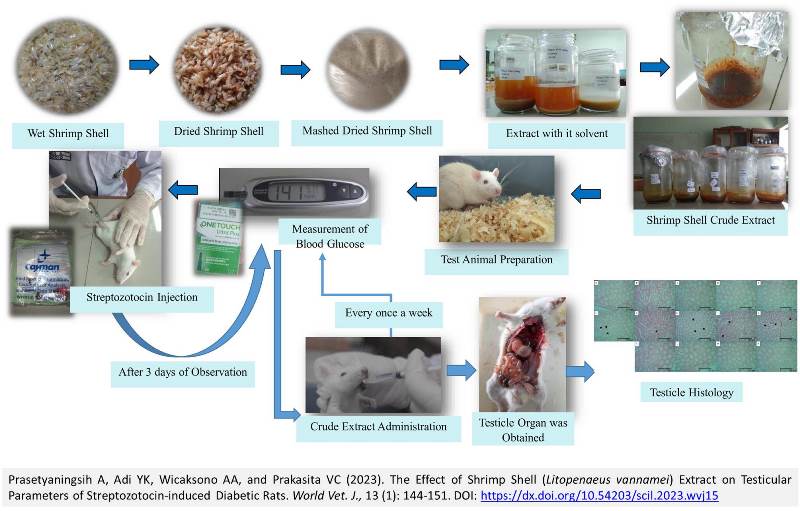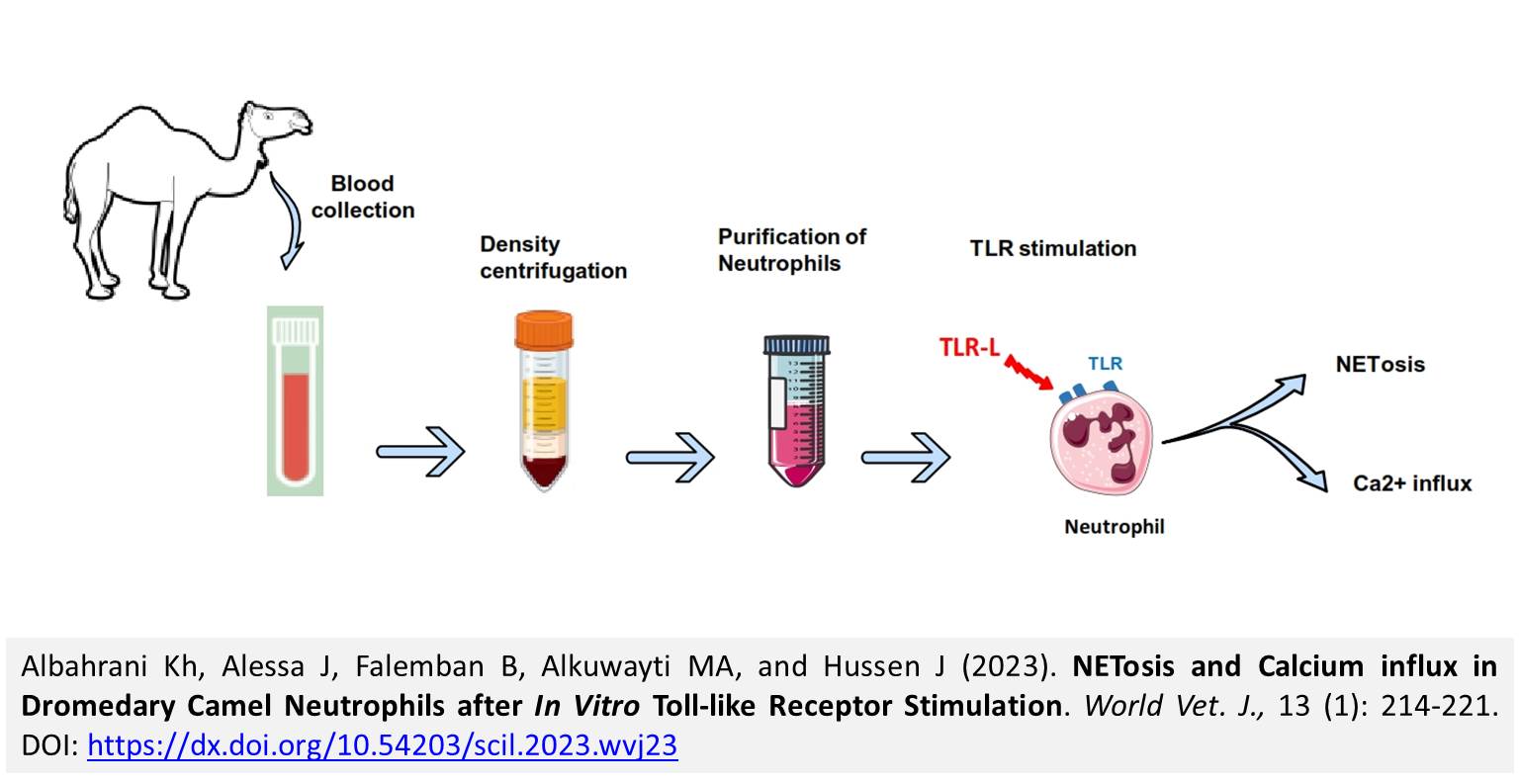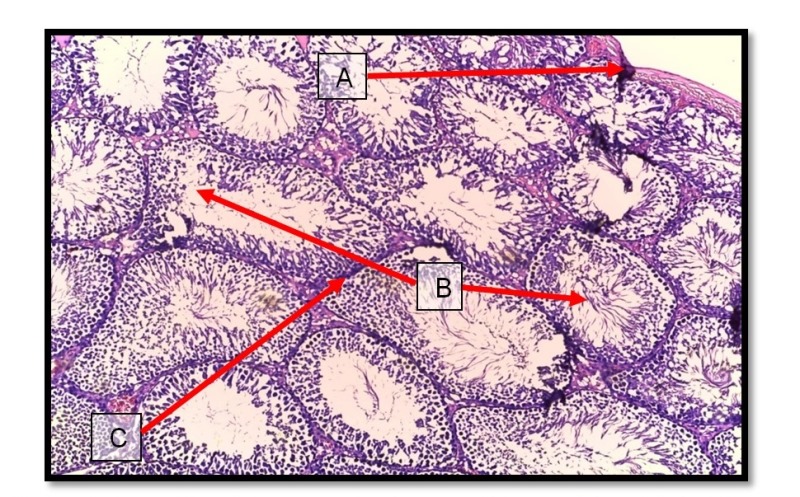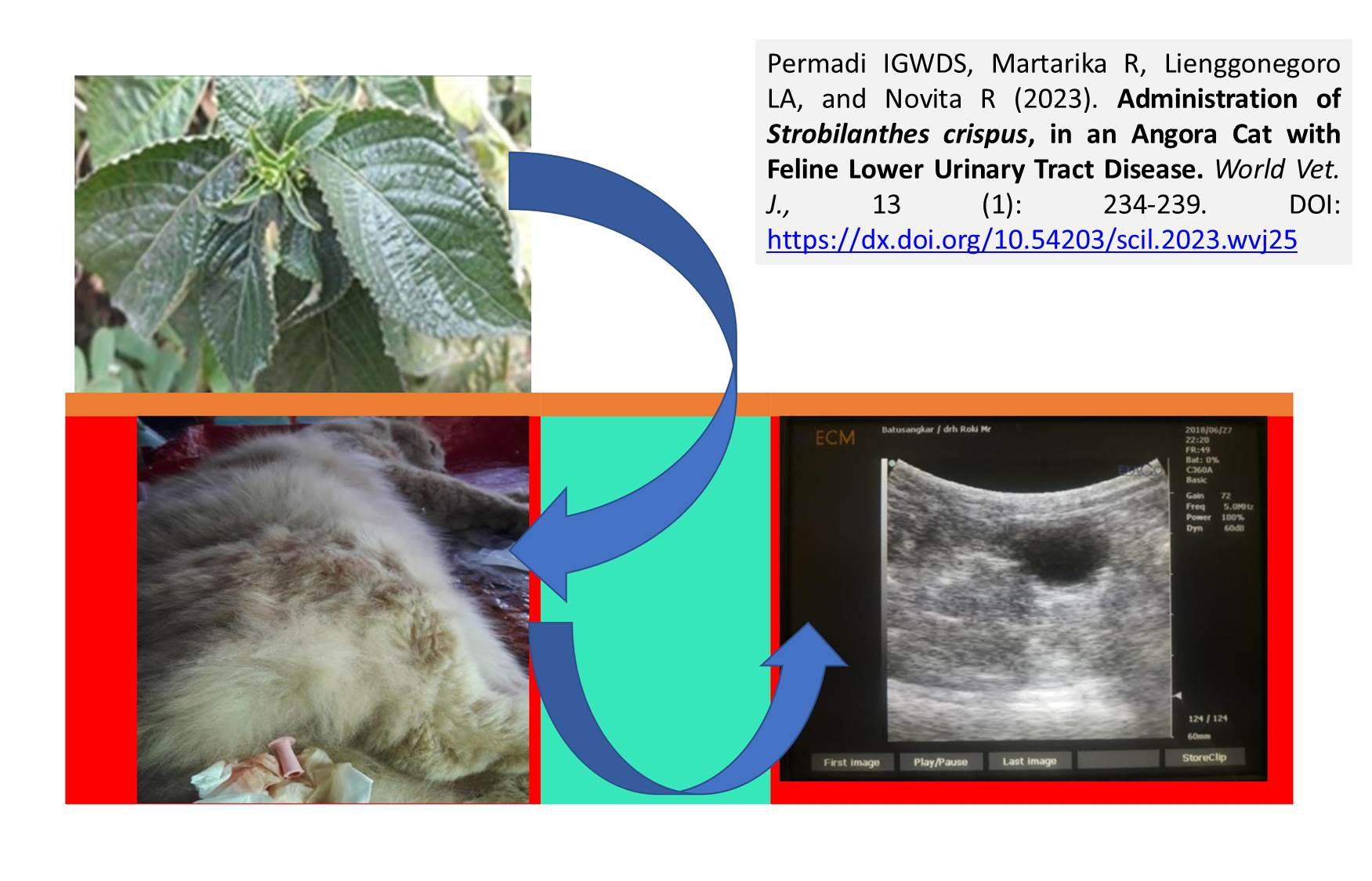Previous issue | Next issue | Archive
![]() Volume 13 (1); March 25, 2023 [EndNote XML for Agris]
Volume 13 (1); March 25, 2023 [EndNote XML for Agris]
The Role of Head Associated Lymphoid Tissues in Infectious Bronchitis Virus
Al-Rasheed M and Shawky M.
World Vet. J. 13(1): 01-11, 2023; pii:S232245682300001-13
DOI: https://dx.doi.org/10.54203/scil.2023.wvj1
ABSTRACT: Infectious bronchitis virus (IBV) replicates primarily in the epithelial tissues of the respiratory tract, particularly the trachea. However, little is known about IBV replication and immune responses in relation to head-associated lymphoid tissue (HALT), such as the Harderian gland (HG) and choanal cleft, as well as respiratory (turbinate) tissues. Furthermore, few studies have looked into the role of the HG, choanal cleft, pharyngeal tissues, and turbinate in innate, cellular, and mucosal immune responses of commercial broiler chickens and laying hens infected with IBV, compared to the studies about the effects on the trachea. This review article overviewed the role of avian HALT, conjunctival-associated lymphoid tissue (CALT), concerning the anatomical, physiological, and immune responses to infectious bronchitis disease in chickens. The HG, choanal cleft, and turbinate in innate, mucosal, and cellular immune responses play a significant role in avian protection through virulent or attenuated vaccines of IBVs. The IBV viruses could not reach the trachea in chickens vaccinated with IBV vaccine due to the inhibition of viruses by HALT and respiratory tissues by innate, mucosal, and cellular immunity. It can be concluded that other than the trachea, the HALT and respiratory tissues play an important role in the infectivity and immune induction against IBVs due to their proximity to the upper air passages.
Keywords: Avian immunity, Chicken, Harderian gland, Infectious bronchitis, Turbinate
[Full text-PDF] [Crossref Metadata] [Scopus] [Export from ePrints]
An Overview of Adenovirus Vector-based Vaccines against SARS-CoV-2
Zeedan GSG, Abdalhamed AM, Naguib AM, Shalaby SIA, Awad MAM, and Abd El Moniem MI.
World Vet. J. 13(1): 12-25, 2023; pii:S232245682300002-13
DOI: https://dx.doi.org/10.54203/scil.2023.wvj2
ABSTRACT: Adenovirus vectors have been employed to develop a vaccine against severe acute respiratory syndrome coronavirus 2 (SARS-CoV-2) for curtailing the Covid-19 pandemic spreading. Many different viral vectors have been mainly targeting the SARS-CoV-2 spike (S) protein as an antigen. Spike (S) protein is comprised of S1 and S2 subunits, in which the receptor-binding domain (RBD) of S1 is responsible for recognizing and engaging with its host cellular receptor protein angiotensin-converting enzyme 2 (ACE2), S2 accounts for membrane fusion of virus and host cell. Chimpanzee adenovirus was also used as a vector vaccine for SARS-CoV-2 (ChAdSARS-CoV-2-S) by intramuscular injection, and intranasal administration has been tested. Adenovirus vector-based vaccines are the most advanced, with several vaccines receiving Emergency Use Authorization (EUA). It was shown that rhesus macaques were protected from SARS-CoV-2 challenge after a month of being vaccinated with ChAd-SARS-CoV-2-S. A single intranasal or two intramuscular ChAd-SARSCoV-2-S vaccines could induce humoral antibodies and T cell responses to protect the upper and lower respiratory tract against SARS-CoV-2. As the effectiveness was demonstrated in non-human primates, ChAd-SARS-CoV-2-Sa potential option for preventing SARS-CoV-2 infection in humans. However, detecting novel more transmissible and pathogenic SARS-CoV-2 variants added concerns about the vaccine efficacy and needs monitoring. Moreover, the cause of recently documented rare cases of vaccine indicated immune thrombotic thrombocytopenia. This review article provided details for the adenovirus vector vaccine for SARS-CoV-2 in humans and tried to provide solutions to the adenovirus vector hemagglutinin issue.
Keywords: ACE2, Adenovirus, Immune response, SARS-CoV-2, Spike protein, Vaccine, Viral vectors
[Full text-PDF] [Crossref Metadata] [Scopus] [Export from ePrints]
Efficacy of Hemagglutinin Gene of Highly Pathogenic Avian Influenza as a Vaccine Candidate in Poultry: A Review
Prayugo AD, Subroto T, and Arnafia W.
World Vet. J. 13(1): 26-31, 2023; pii:S232245682300003-13
DOI: https://dx.doi.org/10.54203/scil.2023.wvj3
ABSTRACT: The most prevalent fatal disease in poultry that can result in high morbidity and mortality is highly pathogenic avian influenza (HPAI), subtype H5N1. A vaccination program is the most frequent way to prevent HPAI cases in poultry, especially against the H5 subtype of HPAI. There are currently a number of avian influenza vaccines available, including recombinant and inactivated whole virus vaccines. The foundation of a recombinant vaccine is possible by the expression of an avian influenza gene of interest following insertion into a carrier vector (no pathogenic virus). A recombinant HPAI vaccine is required to further challenge avian influenza cases in poultry. As a recombinant vaccine inserted into a carrier vector, the hemagglutinin (HA) gene has proven effective. The recombinant Herpes Virus Turkey (rHVT) vector vaccine for avian influenza has been discovered and is commercially available. The rHVT vaccine was developed using a hemagglutinin insert from the HPAI virus clade 2.2. Overall, studies in this review aimed to determine the efficacy of any developed recombinant avian influenza vaccine that uses the HA gene from different clades challenged with any avian influenza virus (AIV) isolate. It was found that the efficacy of hemagglutinin as a recombinant vaccine could be promising for future HPAI vaccine development. In addition, it is possible to design a recombinant vaccine using local isolates to protect poultry farms, particularly in endemic regions.
Keywords: Avian influenza, Efficacy, Hemagglutinin, Poultry, Recombinant vaccine
[Full text-PDF] [Crossref Metadata] [Scopus] [Export from ePrints]
Occurrence of Antibiotic Resistance in Salmonella Serotypes Isolated from Environment, Humans, Animals, and Animal Products in Morocco: A Systematic Review
El Hanafi M, Nourredine B, Saadia N, and Hakim K.
World Vet. J. 13(1): 32-44, 2023; pii:S232245682300004-13
DOI: https://dx.doi.org/10.54203/scil.2023.wvj4
ABSTRACT: Several studies have been carried out in Morocco on Salmonella contamination in humans, domestic and wild animals, food products, and the environment. This bacterial genus is responsible for several infections and foodborne illnesses worldwide. The epidemiological situation of contamination by Salmonella is worsened by the development of antibiotic resistance to the main antibiotics used in human and veterinary medicine. The purpose of this study was to review the leading research carried out in this field, emphasizing the antibiotic resistance of this bacterium to antibiotics in humans and animals. Although some studies could not demonstrate the presence of Salmonella in the environments studied, the prevalence of contamination remained relatively high in humans, animals, food products, and the environment. The most critical contaminations were observed in poultry farms and poultry meat. Salmonella causes 42.8% of food poisoning cases in Morocco. It is the second most common cause of poisoning after pesticide poisoning. Morocco ranks first in the Middle East and North Africa for human salmonellosis, with a prevalence of 17.9% (1997-2012). Its prevalence in food products, especially those of animal origin, is very high and could reach 52.9% in turkey meat. Food products have been studied more for their contamination by Salmonella species. Meat products accounted for 17.35% of food poisoning cases. This study revealed that the isolation rate of Salmonella from food products of animal origin was dominated by isolations from meat products, with prevalence rates of 41.76 % from red meat and meat products and 25.88% from poultry meat, followed by prevalence rates of 12.44 % from fish products and 11.80 % from eggs. On the coast of Agadir, the incidence rates of Salmonella were 6.8% and 4.1% in sediment and seawater, respectively. This occurrence was 2.38% in the surface waters of Oued Khoumane. The development of resistance, particularly multi-resistance to antibiotics of therapeutic interest in both humans and animals, is alarming, especially with the ease of transmission of the bacterium to humans and facilitates its dissemination. Research findings indicated that 93.02% of isolates of Salmonella from humans, 79.37% of the strains isolated from poultry, and 46.27% of isolates from food products were resistant to at least one antibiotic.
Keywords: Animals, Environment, Food products, Foodborne disease, Salmonella, Resistance
[Full text-PDF] [Crossref Metadata] [Scopus] [Export from ePrints]
Strategies for Prevention and Control of Multidrug-resistant Bacteria in Ruminants
Gamil Zeedan GS, Abdalhamed AM, and Ghazy AA.
World Vet. J. 13(1): 45-56, 2023; pii:S232245682300005-13
DOI: https://dx.doi.org/10.54203/scil.2023.wvj5
ABSTRACT: Antibiotics are no longer effective in treating bacterial infections due to antimicrobial drug resistance. Therefore, various alternative strategies have been developed to combat multidrug-resistant (MDR) bacteria. The current review article aimed to shed light on strategies to prevent and control MDR bacteria in ruminants. Due to the development of new resistant bacteria, there is a need for effective treatments and prevention protocols in livestock and humans. With growing antibiotic-resistant organisms, a few antimicrobial medicines will be available to treat the infection when no new drugs are developed. This highlights the importance of looking for other strategies for combating antibiotic-resistant bacteria. In this regard, alternative strategies have been proposed to minimize antimicrobial drug overuse in ruminants. These alternative procedures include alternatives for growth promotion (such as in-feed enzymes, probiotics, prebiotics, synbiotics, and antimicrobial peptides), alternatives for disease prevention (such as vaccines, immune modulators, chicken egg yolk antibodies, farm management, and biosecurity), and alternatives for disease treatment such as plant extracts and phage-therapy to antibiotics. These alternative methods should be safe and efficient without inducing microbial resistance.
Keywords: Antibiotic, Bacteria, Multidrug-resistant, Medicine, Ruminants
[Full text-PDF] [Crossref Metadata] [Scopus] [Export from ePrints]
The Prevalence of Gastrointestinal Nematodes in Livestock and their Health Hazards: A Review
Khan A, Jamil M, Ullah S, Ramzan F, Khan H, Ullah N, Ali M, Rehman AU, Jabeen N, and Amber R.
World Vet. J. 13(1): 57-64, 2023; pii:S232245682300006-13
DOI: https://dx.doi.org/10.54203/scil.2023.wvj6
ABSTRACT: Livestock plays an important role in the national economy and has a significant share in the gross domestic product of Pakistan. Parasitic diseases and worm infestations negatively affect their health, production, and reproductive performance. In addition, parasitic infestation in livestock reduces gross production values and renders huge economic losses globally. Among the parasites, the most important are nematodes. They are distributed worldwide and affect all kinds of livestock. This review aimed to elaborate on the main gastrointestinal nematodes, their mode of action, impacts on livestock and their control (physical, chemical or biological) strategies. Common examples of nematode worms infesting the livestock are Ascaris, Hemonchus, Strongyloids, Trichostrongyliods, Ostertagia, Trichuris, Dictyocaulus, Trichnellia, Enterobius, Cooperia, Gunagylonema, Chabertia, and Oesphagostomum. The gastrointestinal nematodes are detrimental to the animals’ health. Nematodes primarily affect animals’ feed consumption and efficiency, and severe ailments result in the death of the affected animals. The production and health losses primarily depend on the age of the animals, the degree of severity of worm infestation, epidemiology pattern of the parasites, management strategies of the flocks, and ecoclimatic conditions which are favorable for the worm’s infestation. To minimize these issues, farmers should be educated on the importance of intensive livestock management and environmental sanitation, as well as strategic deworming of cattle using efficient broad-spectrum anthelmintics, biological control of the parasites, and breaking their life cycle and intermediate hosts.
Keywords: Ascaris, Enterobius, Hemonchus, Nematode, Parasitism, Roundworms, Strongylus
[Full text-PDF] [Crossref Metadata] [Scopus] [Export from ePrints]
Trichinella spiralis as a Potential Antitumor Agent: An Update
Sadr S, Yousefsani Z, Ahmadi Simab P, Jafari Rahbar Alizadeh A, Lotfalizadeh N, and Borji H.
World Vet. J. 13(1): 65-74, 2023; pii:S232245682300007-13
DOI: https://dx.doi.org/10.54203/scil.2023.wvj7
ABSTRACT: Due to the limited success of therapeutic strategies in treating tumors, a new practical potent approach is needed. This review aimed to investigate previous literature related to tumors and Trichinella spiralis (T. spiralis). In recent years, there has been growing interest in utilizing biological, viral, bacterial, yeast, and parasitic agents to cure cancers. According to several studies, some parasites could interferee with the tumors’ growth. There has been much discussion about some parasites’ applications to cure tumors in animals and humans. In studies, T. spiralis was found to have antitumor properties. The active proteins in T. spiralis, such as Caveolin-1, Heat shock proteins, and Ribosomal proteins, are thought to inhibit the growth of cancers, such as melanoma, myeloma, sarcoma, leukemia, stomach cancer, colon cancer, breast cancer, and lung cancer. In addition, these proteins are thought to induce apoptosis in specific neoplastic cells. Accordingly, antigens derived from parasites may be helpful in cancer immunotherapy. However, there are still many unanswered questions regarding Trichinella spiralis’ potential use as a biotherapy agent against cancer. Future studies should focus on the purification of parasite antigens and their use for wider-scale trials in animal models.
Keywords: Antitumor, Apoptosis, Cancer, Immunotherapy, Trichinella spiralis
[Full text-PDF] [Crossref Metadata] [Scopus] [Export from ePrints]
The Effects of Grounded Herbs on the Intestinal Villus Height and Shedding of F18-positive Escherichia coli in Weaned Pigs
Laxaphakdy Ch, Jiwakanon J, Supankong S, Papirom P, Tanpong S, and Porntrakulpipat S.
World Vet. J. 13(1): 75-84, 2023; pii:S232245682300008-13
DOI: https://dx.doi.org/10.54203/scil.2023.wvj8
ABSTRACT: Antibiotics have been widely used to control and treat infections caused by Escherichia coli (E. coli) in weaned pigs. The bacteria resistance to antibiotics can occur naturally; however, the misuse of antibiotics can accelerate this resistance. New antibiotics are developed very slowly, and only two new classes of antibiotics have been developed in the past 40 years. This makes herbal medicine a promising method for fighting against antibiotic-resistant bacteria. In the current study, 25 male crossbred (Duroc x Landrace x Large white) weaned piglets with an average weight of 6-8 kg were examined for 24 days. The pigs were randomly assigned to five groups in a completely randomized design with five replicates (1 pig/pen). All treatments included 20% crude protein corn-soybean as the basal diet. The negative control group received no supplementation, while pigs in the second experimental group received a basal diet supplemented with 150 ppm colistin sulfate. Basal diet and herbal mixture (Andrographis paniculata, Zingiber cassumunar, and Garcinia mangostana) were fed to three other experimental groups at 500, 1000, and 2000 ppm. The F18-positive, colistin-resistant E. coli were orally inoculated to all pigs for 9 days. The antibacterial and anti-diarrheal effects of this diet and its effect on the inoculated pigs’ intestinal villi were evaluated. The results indicated that supplementation of this herbal mixture at levels of 500, 1000, and 2000 ppm had antibacterial effects, with no significant difference between doses. However, the positive effects of this herbal mixture on intestinal villi height and diarrhea were found only in pigs that received 1000 and 2000 ppm of the herbal mixture. From a practical point of view, supplementation of this herbal mixture at 500 and 1000 ppm could be applied for prophylaxis during the weaning period, whereas 2000 ppm of the herbal mixture could be used for the treatment of postweaning E. coli diarrhea.
Keywords: Andrographis paniculate, Escherichia coli, Garcinia mangostana, Herbal mixture, Zingiber cassumunar
[Full text-PDF] [Crossref Metadata] [Scopus] [Export from ePrints]
Investigation of Antibiotic Resistance Pattern and Virulence Determinants in Avian Pathogenic Escherichia coli Isolated from Broiler Chickens in Egypt
Hamed BM, Elenbaawy MI, Mahmoud H, and Ragab E.
World Vet. J. 13(1): 85-94, 2023; pii:S232245682300009-13
DOI: https://dx.doi.org/10.54203/scil.2023.wvj9
ABSTRACT: Besides its zoonotic importance, avian pathogenic Escherichia coli (APEC) causes substantial financial losses in the poultry industry globally. The progress of antimicrobial resistance in APEC is mainly associated with excessive antimicrobial use and improper sanitation. Since its beginning in the 1970s, the VITEK system has developed into the VITEK 2 system, which has used an automated system to perform all the steps required for microbial identification and antibiotic susceptibility rapidly and accurately. The present study aimed to update the available circulating data about APEC isolates by phenotypic identification, sero-grouping of APEC from broilers chickens and breeders in five governates of Egypt, investigation of their antibiotic resistance pattern by VITEK 2 system, and molecular identification of their virulence determinants. The prevalence of APEC isolated from the different internal organs (liver, lung, heart, heart blood, and spleen) was 67.5%. The most prevalent serotypes were O125, 0114, O44, O127, O142, and O78. Virulence-associated genes (iutA, fimC, and papC) were detected at rates of 84.4%, 74%, and 54.8%, respectively. The highest resistance was found against ampicillin (100%), trimethoprim-sulfamethoxazole (80%), and ampicillin-sulbactam (78.5%), which indicates that the poultry farms need a surveillance and intervention system with proper accuracy and rapidity to prevent the misuse of antibiotics and APEC outbreaks.
Keywords: Escherichia coli, Colibacillosis, PCR, VITEK, Virulence genes
[Full text-PDF] [Crossref Metadata] [Scopus] [Export from ePrints]
Effects of the Anthocyanin Compound (Cyanidin-3-glucoside) on some Histological and Physiological Parameters Related to the Heart in Male Rats Exposed to Oxidative Stress
Yasser H and Sabour AN.
World Vet. J. 13(1): 95-102, 2023; pii:S232245682300010-13
DOI: https://dx.doi.org/10.54203/scil.2023.wvj10
ABSTRACT: The increasing incidence of heart disease due to an unhealthy diet rich in fats has encouraged the use of plant extracts, which have shown efficiency in improving body immunity and promoting human health. The current study was designed to investigate the effect of anthocyanin cyanidin-3-glucoside on some physiological and histological parameters related to the heart in white male rats exposed to oxidative stress with hydrogen peroxide. The study included 48 adult male white rats with a weight range of 200-300 g, and an ages range of 8-12 weeks. The rats were randomly divided into six groups of eight rats per group. Group 1 was considered a negative control group supplied with water and the basal diet for 30 days. Group 2 was a positive control group in which the rats were given drinking water containing hydrogen peroxide at a concentration of 1%. The third group orally received cyanidin-3-glucoside at a concentration of 50 mg/kg. The fourth group received both cyanidin-3-glucoside compounds at a concentration of 70 mg/kg and drinking water containing hydrogen peroxide at a concentration of 1%. The fifth group was dosed orally with a cyanidin-3-glucoside only at a concentration of 50 mg/kg, and the sixth group was dosed orally with a cyanidin-3-glucoside at a concentration of 70 mg/kg. At the end of the experiment, the animals were anesthetized, then blood samples were collected from the heart directly to obtain serum for measuring the levels of troponin, lactate dehydrogenase (LDH), and creatine kinase (CK-MB). The results showed a significant increase in troponin, LDH, and CK-MB levels in the positive control group compared to the negative control group. However, there was a significant decrease in the level of these enzymes in the third and fourth groups, compared to the positive control group. The fifth and sixth groups demonstrated a significant decrease, compared to the positive control group. However, they revealed a nonsignificant difference in the levels of these parameters, compared to the negative control group. The obtained results indicated that the cyanidin-3-glucoside compound positively prevented heart muscle damage caused by oxidative stress.
Keywords: Anthocyanin compound, Heart, Hydrogen peroxide, Male rats, Oxidative stress, Physiological parameter
[Full text-PDF] [Crossref Metadata] [Scopus] [Export from ePrints]
Incidence and Hematological Changes in Dogs Infected with Dirofilaria immitis in Thailand
Kulnides N, Lorsirigool A, Pumipuntu N, Chantrarasmee Ch, and Janthong N.
World Vet. J. 13(1): 103-108, 2023; pii:S232245682300011-13
DOI: https://dx.doi.org/10.54203/scil.2023.wvj11
ABSTRACT: Dirofilaria immitis is responsible for heartworm disease in dogs. Clinical signs are non-specific, ranging from asymptomatic to severe symptoms. The most common symptoms include coughing, emaciation, dyspnoea, and sudden loss of consciousness. Therefore, diagnosing heartworm infection in dogs requires a combination of methods, such as hematology and serology. This study was conducted on dogs with clinical signs, including anorexia, coughing, panting, and hind legs weakness, that was referred accidentally to a pet clinic in Thonburi district, Bangkok Province, Thailand, during 2020-2022. The examination was performed using a rapid enzyme immunoassay test and a thin blood smear. The total number of dogs admitted to a pet clinic during that period was 980. The result indicated infection of 21 (12 male and 9 female) dogs with heartworm (2.14%). The mean age of dogs was 5.62 ± 2.48 years. All infected dogs were classified under an open husbandry system that did not consistently use heartworm prevention products such as the macrocyclic lactone group. In the groups that received topical ectoparasites products, 10 dogs were detected with heartworm infection. The hematological changes in the infected dogs consisted of leucocytosis and increased levels of ALT, BUN, and creatinine. The study results can guide owners in choosing products that can prevent heartworm. Anti-mosquito nets should be deployed in areas where pets live, and always keep the environment clean.
Keywords: Dog, Heartworm, Hematology, Serum biochemistry
[Full text-PDF] [Crossref Metadata] [Scopus] [Export from ePrints]
Knowledge, Attitudes, and Practices of Red Meat Handlers in Moroccan Slaughterhouses
Bahir MA, Sarhane B, Errachidi I, Tantane A, Mohammed A, Belkadi B, and Filali-Maltouf A.
World Vet. J. 13(1): 109-124, 2023; pii:S232245682300012-13
DOI: https://dx.doi.org/10.54203/scil.2023.wvj12
ABSTRACT: Meat handlers are vectors of pathogens in slaughterhouses and can play a major role in the microbiological contamination of meat. The level of knowledge of meat handlers in slaughterhouses is a critical factor in food safety. Good hygienic practices in the slaughterhouse are required to reduce the risk of microbiological contamination while handling meat. This study evaluated workers’ knowledge, attitudes, and practices in four municipal slaughterhouses in Morocco. A total of 267 employees were evaluated using a structured survey. The results showed that workers had acceptable knowledge and practices, and their attitudes were very satisfactory, averaging 52.87%, 50.9%, and 63.07%, respectively. A positive correlation between the workers’ level of knowledge and education was found in all studied slaughterhouses. Similarly, the results indicated a positive correlation between knowledge and attitudes at Meknes and Kenitra slaughterhouses. The impact of the studied sociodemographic characteristics may vary from one slaughterhouse to another. In conclusion, the study suggested that although the knowledge, attitudes, and level of practice of food handlers were very satisfactory, some aspects related to the control of the health status of the handlers and personal protective equipment had to be underlined. Ongoing food safety training should become mandatory to enhance food safety in the slaughterhouses of study locations.
Keywords: Attitudes, Food Safety, Hygienic practices, Knowledge, Slaughterhouse
[Full text-PDF] [Crossref Metadata] [Scopus] [Export from ePrints]
The Effect of Sausage Tree Fruit (Kigelia africana) on Gonadal Development and Growth Performance of Oreochromis andersonii
Sianangama PC, Nundwe E, Harrison SJ, Nambeye E, and Abigaba R.
World Vet. J. 13(1): 125-133, 2023; pii:S232245682300013-13
DOI: https://dx.doi.org/10.54203/scil.2023.wvj13
ABSTRACT: In Zambia fish farms, Oreochromis andersonii is an important common indigenous fish species. Naturally, safe phytochemicals can effectively improve fish reproduction performance and their production potential. Therefore, this study was conducted to determine the effect of Kigelia africana on the gonadal development and the performance of Oreochromis andersonii. A total of 96 male fingerlings were randomly assigned to four dietary treatments (D1-D4), and each treatment group had three replicates. The D1, D2, D3, and D4 groups were formulated to receive 0, 50, 100, and 150 g of powdered Kigelia africana/kg, respectively. The fish were fed the diets for 9 weeks, followed by the study parameter measurements at the end of the experiment. The highest mean body weight and gonadal weight were (29.8 ± 0.63 and 0.09 ± 0.010 g, respectively) for fish in the D2 group. There was no significant difference between the mean body weight of fish in different groups, but their mean gonadal weights differed significantly. The gonadal somatic index of fish differed significantly among treatment groups, with those in D2 having the highest mean value (0.36 ± 0.060). The highest mean standard length (103.3 ± 0.63 mm) and total length (126.0 ± 0.11 mm) of fish were observed for D1 and D2 groups, respectively. Additionally, the mean values for those parameters decreased with increasing Kigelia africana in the diet. The physicochemical parameters of water, including temperature and dissolved oxygen, ranged 16.8-23.1℃ and 0.6-2.2 mg/L, respectively; these were generally at low levels considering the optimum requirements for this fish species. In conclusion, Kigelia africana improved gonadal growth and development but did not promote overall fish growth. The best gonadal growth/development results of Kigelia africana powder were observed at a level of 50 g/kg, which can be used as a performance booster in the aquaculture production of Oreochromis andersonii.
Keywords: Aquaculture, Gonadal development, Growth, Kigelia africana, Oreochromis andersonii, Sausage tree
[Full text-PDF] [Crossref Metadata] [Scopus] [Export from ePrints]
The Relationship between Warm Weather and Milk Yield in Holstein Cows
Mylostyvyi R, Izhboldina O, Midyk S, Gutyj B, Marenkov O, and Kozyr V.
World Vet. J. 13(1): 134-143, 2023; pii:S232245682300014-13
DOI: https://dx.doi.org/10.54203/scil.2023.wvj14
ABSTRACT: The increasing variability of weather conditions associated with global climate change is becoming a major problem for dairy farming. The present article provided the results of studies on the relationship between the milk production of Holstein cows and environmental parameters during the warm season. The study investigated whether the relationship between weather conditions (air temperature, relative humidity, wind direction, wind strength, and insolation) and daily milk yield, as well as its components (milk fat yield and milk protein), depended on the conditions comfortable for the cows. The temperature-humidity index was calculated based on air temperature and relative humidity data, which were recorded by the nearest weather station to the farm, which is subordinate to the Ukrainian Hydrometeorological Center. It was found that the relationship between environmental parameters and milk yield was weak concerning the increase in proportion to the growth of heat load. However, the factorial analysis indicated that the total influence of weather factors on milk yield, milk fat, and protein yield was 42-46%. Moreover, weather conditions could significantly impact dairy productivity when cows are kept in naturally ventilated barns. This suggests further investigation of issues related to the microclimate improvement in cowsheds in hot seasons using sprinkler systems for cooling dairy cows.
Keywords: Сomponents of milk, Correlation, Cows, Hot weather, Milk yield, Naturally ventilate
[Full text-PDF] [Crossref Metadata] [Scopus] [Export from ePrints]
The Effect of Shrimp Shell (Litopenaeus vannamei) Extract on Testicular Parameters of Streptozotocin-induced Diabetic Rats
Prasetyaningsih A, Adi YK, Wicaksono AA, and Prakasita VC.
World Vet. J. 13(1): 144-151, 2023; pii:S232245682300015-13
DOI: https://dx.doi.org/10.54203/scil.2023.wvj15
ABSTRACT: Diabetes mellitus (DM) is a chronic metabolic disorder that has become a major health problem worldwide. Reproductive dysfunction is one of the main complications of DM, particularly in men. However, as is known, shrimp shell extract contains nutrients, such as astaxanthin, that affect reproductive traits. The present study aimed to evaluate the effect of shrimp shell extract on the volume, weight, and histological features of the testes of a DM rat model. Fifteen adult male rats were randomly divided into three groups. Group A (n = 5) was a healthy control group, group B (n = 5) was a DM control group, and group C (n = 5) was a DM group treated with shrimp shell extract. Rats in groups B and C were treated with streptozotocin to induce DM. Rats in group C were given shrimp shell extract at 25 mg/kg body weight for 30 consecutive days after DM induction. Testicles were collected and submitted to dimension, weight, and histological examinations. The testicle volume and weight of rats in group C were significantly higher and heavier, respectively, than rats in group B and did not differ from rats in group A. The seminiferous tubule diameter of rats in group C was significantly larger than rats in group B and did not differ from rats in group A. Rats in group B had a lower testicle volume and lighter testicle weight as well as a shorter seminiferous tubule diameter than rats in groups A and C. In conclusion, shrimp shell extract could improve male fertility parameters in a DM rat model. However, the mechanism of action needs to be studied further.
Keywords: Astaxanthin, Diabetes mellitus, Fertility, Seminiferous tubule, Testis
[Full text-PDF] [Crossref Metadata] [Scopus] [Export from ePrints]
Investigation of Ovarian and Non-ovarian Associated Factors Related to Follicular Population and Oocyte Maturation of Chadian Cattle Breeds
Hachim S, Tchoffo H, Jean-Pierre MK, Azafack DK, and Ngoula F.
World Vet. J. 13(1): 152-166, 2023; pii:S232245682300016-13
DOI: https://dx.doi.org/10.54203/scil.2023.wvj16
ABSTRACT: A cow can give birth to an average of 6-7 calves in her entire reproductive period. The remaining oocytes could be used for the in vitro production of embryos. The present study was conducted to evaluate the effects of ovarian and non-ovarian factors on the follicular population and oocyte maturation of three Chadian cattle breeds (Arab, Kouri, and Toupouri). For this purpose, the ovaries of 166 cycled cows were collected at the Farcha slaughterhouse of Chad and placed individually in labeled conical tubes containing 0.9% NaCl and 0.5 mg/ml penicillin-streptomycin. After clearing the ovaries of tissue debris, they were weighed, and the follicles were counted. The diameter of each follicle was measured and classified into three categories. A total of 2734 oocytes were collected in 28 days with a minimum of 97 per day by the slicing method using a 10X stereoscope. They were then classified into four groups according to the structure of their cumulus oophorus. Immature oocytes (class 1 and 2 [1455]) were placed in different culture media consisting of Minimum Essential Medium (MEM) alone, MEM with 10% follicular fluid, and MEM with 50% follicular fluid for oocyte maturation. The results indicated that the mean follicular population and mean oocyte yield were 24.71 ± 0.88 and 11.65 ± 0.94, respectively. The mean oocyte index and the number of cultivable oocytes for in vitro embryo production (class 1 and 2) were 1.03 ± 0.23 and 1.65 ± 0.94, respectively. The number of follicles observed in the age group of 6-9 years was higher than in other age groups. Oocyte yield was significantly higher in cows with a body condition score of 4-5 compared to average and lean cows. Among the different culture media used for oocyte maturation, the medium consisting of MEM plus 10% follicular fluid recorded a higher maturation rate than the other culture media. Cows aged 6-9 years had a higher maturation rate than other age groups. In conclusion, the good follicle (follicle that produced oocyte) and appropriate oocyte performance were observed in cows with body condition score 3-5 and an age range of 6-9 years.
Keywords: Age, Breed, Cattle, Maturation, Oocyte
[Full text-PDF] [Crossref Metadata] [Scopus] [Export from ePrints]
Antibiotic Resistance of Escherichia coli and Salmonella Species Isolated from Table Eggs in Morocco
El Ftouhy FZ, Hmyene A, Nacer S, Kadiri A, Charrat N, Fagrach A, Derqaoui S, and Nassik S.
World Vet. J. 13(1): 167-174, 2023; pii:S232245682300017-13
DOI: https://dx.doi.org/10.54203/scil.2023.wvj17
ABSTRACT: The development of antimicrobial resistance has become a severe global public health emergency. Foods of animal origin are considered possible drivers of resistant bacteria, including Escherichia coli (E. coli) and Salmonella spp. It is associated with the indiscriminate use of antibiotics, resulting in the inability to treat patients infected with antibiotic-resistant pathogens and a high risk of transmission of these resistant pathogens. The current study aimed to determine the prevalence and antibiotic resistance of E. coli and Salmonella spp. in raw table eggs in Morocco. A total of 870 table eggs resulting from 290 samples (3 eggs = 1 sample), were purchased from ambulatory sellers, street vendors, kiosks, and neighborhood markets from different cities in Morocco and transferred to the laboratory in the Hassan II Agronomy and Veterinary Medicine Institute of Rabat, Morocco. The egg shells and contents were tested separately then the isolation and identification of bacterial pathogens were performed according to the Moroccan Standard Norms. The bacterial isolates were tested for susceptibility to six commonly used antibiotics, namely nalidixic acid (30 µg), kanamycin (30 µg), gentamycin (15 µg), ciprofloxacin (15 µg), tetracycline (30 µg), and amoxicillin (10 μg). The findings revealed that 38 samples (13%) tested positive for E. coli of which 9% were on egg shells, and 4% were in egg content, while for Salmonella enteritidis (S. enteritidis), 5 samples (2%) tested positive and only in the egg contents. Escherichia coli showed the highest resistance to amoxicillin, followed by tetracycline and nalidixic acid with 92.10%, 84.21%, and 50%, respectively, and was sensitive to ciprofloxacin (84.21%), kanamycin (65.79%), and gentamicin (60.54%). Salmonella enteritidis had the highest resistance against tetracycline (80%), followed by ciprofloxacin and nalidixic acid with 40% each. The highest sensitivity rates of S. enteritidis were for gentamicin, amoxicillin, and kanamycin at 80%, 80%, and 40%, respectively. Given that these resistant bacteria could potentially be transferred to humans through eggs or egg products, it is necessary to employ strict hygiene measures and provide a wise and legal use of antibiotics in animal breeding.
Keywords: Antibiotic resistance, Escherichia coli, Salmonella enteritidis, Table egg
[Full text-PDF] [Crossref Metadata] [Scopus] [Export from ePrints]
A Retrospective Study on Dairy Cattle Mortality Patterns in Two Farms of South-eastern Botswana
Mosalagae D, Mogotsi K, Ithuteng IM, Basinyi O, and Pfukenyi DM.
World Vet. J. 13(1): 175-182, 2023; pii:S232245682300018-13
DOI: https://dx.doi.org/10.54203/scil.2023.wvj18
ABSTRACT: Generally, high mortalities of dairy cattle due to infectious and non-infectious diseases cause huge economic losses, unprofitability, and low productivity in the dairy industry. The present study aimed at determining the mortality rates, their causes, and risk factors among 1779 cattle at two dairy farms belonging to the Department of Agricultural Research, Botswana. An 8-year retrospective study was conducted using farm records during 2005-2012. Monthly and annual records of the farms were examined regarding the total dairy cattle population, sex, breed, age, cattle deaths, and causes of death. Mortality was calculated from the total cattle population and expressed as a percentage, and it was analyzed with respect to farm, breed, age, sex, year, season, and mortality causes. The overall mortality rate was 8.5%. The semi-intensively managed Farm II, as well as young stock (<12 months old), and males recorded significantly higher mortalities than their counterparts. Dairy crosses of pure exotic and indigenous Tswana cattle had higher mortalities than the Friesians and Jerseys, and the wet season accounted for over 70% of the total deaths. Only two years (2010 and 2012) out of the 8-year study period had a mortality rate < 5%. Notably, 28.1 % of mortalities with a known cause were due to heartwater disease (n = 57), but most deaths (62.3%) were due to unknown causes. In conclusion, to improve farm herd health and husbandry practices, more efforts should be devoted to preventing heartwater and mortalities in young stock and male animals, particularly during the hot-wet season.
Keywords: Dairy cattle, Heartwater, Mortality, Risk factor
[Full text-PDF] [Crossref Metadata] [Scopus] [Export from ePrints]
Zootechnical Performance and Growth Curve Modelling of the Niamey Local Chickens in Niger
Guisso Taffa A, Issa S, Bachir H, Mahamadou Ch, Johann D, and Nassim M.
World Vet. J. 13(1): 183-190, 2023; pii:S232245682300019-13
DOI: https://dx.doi.org/10.54203/scil.2023.wvj19
ABSTRACT: The Niamey region in Niger depends on imports to meet its chicken meat needs. Although consumers appreciate local poultry products, they cannot fulfill their needs. The reluctance of modern producers to use local chickens on their farms is linked to a lack of knowledge of the production characteristics of local strains, which have been little studied. Thus, this study aimed to determine the growth profile of traditional chickens from villages in the Niamey region (Niger). In doing so, 100 local chicks whose parents were collected in the surrounding villages of the Niamey region were followed from hatching until the age of 140 days. The chickens were raised in cages with 10 per compartment of 3 m length and 1.5 m width. Food consumption was recorded daily, and weights were measured weekly. The parameters of the growth curves were obtained using the Gompertz equation. Female and male chickens had a significant weight difference at the third week of age. The mean weight of chicks at hatching was 24.90 ± 0.36 g. At the end of the follow-up, males, with a mean weight of 1523.05 ± 26.22 g were significantly heavier than females (1052.73 ± 14.04 g). Over the entire period of the experiment, the average daily gain and consumption indices were 9.5 g/d and 5.12, respectively. Asymptotic weights were 2096.78 g and 1313.26 g for males and females, respectively. The maturation factor of the Gompertz equation was higher in females (0.0196 g/d) than in males (0.0181 g/d), and the inflection age averaged 75 days for both sexes. In conclusion, Niamey local chickens are slow growing and have a high feed conversion ratio compared to the modern broiler or layer strains.
Keywords: Average daily gain, Feed conversion ratio, Growth curve, Local chicken, Weight gain
[Full text-PDF] [Crossref Metadata] [Scopus] [Export from ePrints]
Risk Factors Associated with Brucellosis Seropositivity in Goat Farms of Sing Buri Province, Thailand
Thuamsuwan N, Chanachai K, Ekgatat M, Srisai P, Prarakamawongsa T, and Rukkwamsuk Th.
World Vet. J. 13(1): 191-199, 2023; pii:S232245682300020-13
DOI: https://dx.doi.org/10.54203/scil.2023.wvj20
ABSTRACT: During 2012 - 2016, goat farms in Sing Buri province were growing rapidly with support from the Thai government. In the following three years (2017-2019), the analysis of brucellosis surveillance data indicated that the seropositivity of brucellosis in goats increased. Therefore, this study attempted to identify possible risk factors associated with brucellosis seropositivity in meat goats raised in Sing Buri province of Thailand. A case-control study was conducted in a random sampling of 72 goat farms in Sing Buri province, Thailand. Questionnaires were used to collect information regarding farm production types, husbandry, goat health management, grazing management, breeding, carcass management, and goat purchasing. Bivariate and logistic regression analyses were used to determine the risk factors of Brucella seropositivity. Results revealed that the most frequent health complaint by the farmers was a stillbirth. Brucella seropositivity at the farm level was 26.4%. The two most probable risk factors for seropositivity included raising goats in a communal pasture and keeping goats with a history of clinical signs associated with brucellosis. In conclusion, approximately 25% of goat farms in Sing Buri province were infected by the bacteria genus Brucella. The farmers were recommended to attentively seek and cull for a brucellosis-suspected goat in their farms using clinical signs or symptoms together with active serosurveillance. Furthermore, communal pasture avoidance would also help prevent the goat from Brucella infection.
Keywords: Brucellosis, Meat goat, Risk factor
[Full text-PDF] [Crossref Metadata] [Scopus] [Export from ePrints]
Detection and Antimicrobial Susceptibility of Salmonella spp. Isolated From Commercial Eggs in Tiaret Province, Algeria
Merati R and Boudra A.
World Vet. J. 13(1): 200-204, 2023; pii:S232245682300021-13
DOI: https://dx.doi.org/10.54203/scil.2023.wvj21
ABSTRACT: Salmonellosis is a significant public health problem worldwide. The current study aimed to investigate the presence of Salmonella spp. in commercial eggs of Tiaret province, Algeria, and evaluate the susceptibility of isolated strains to different antimicrobial agents. A total of 180 commercial eggs collected from various retail outlets (groceries, butchers, wholesalers, street vendors) were analyzed by conventional methods, and 13 Salmonella spp. isolates were tested on a panel of 7 antimicrobial agents using the disc diffusion method. Of 180 chicken egg content samples examined, the findings indicated that 13 (7.22%) were positive for Salmonella spp. Regarding the collection site, 2 (1.11%), 4 (2.22%), and 7 (3.88%) of Salmonella spp. isolates were detected from butchers, wholesalers, and street vendors, respectively. Most antibiotic discs have demonstrated widespread resistance with an incidence rate of 100%, including amoxicillin + clavulanic acid, ampicillin, nalidixic acid, and erythromycin. However, colistin sulfate, gentamycin, and tetracycline were more effective against Salmonella isolates. It can be concluded that the highest detection rate of Salmonella spp. was observed for street vendors, and the highest resistance was recorded for commonly used antibiotics in poultry production.
Keywords: Antimicrobial, Chickens, Commercial eggs, Salmonella, Tiaret
[Full text-PDF] [Crossref Metadata] [Scopus] [Export from ePrints]
Effects of Phytogenic Feed Additives on Body Weight Gain and Gut Bacterial Load in Broiler Chickens
Engida DT, Ayele M, Waktole H, Tamir B, Regassa F, and Tufa TB.
World Vet. J. 13(1): 205-213, 2023; pii:S232245682300022-13
DOI: https://dx.doi.org/10.54203/scil.2023.wvj22
ABSTRACT: Phytogenic feed additives (PFAs) have promising importance in chicken production as antibiotic alternatives to balance chicken gut microorganisms and improve productivity. The objectives of this study were to evaluate the body weight gain (BWG) and gut bacterial load of broiler chicks fed on selected herbs. For this experiment, 360 unsexed one-day-old broiler chicks of Cobb 500 with an average weight of 40.74 g were randomly allocated into six treatment groups with three replicates of 20 chicks in each pen. The treatment 1 (T1) group was fed by a basal diet alone. Chickens of T2, T3, T4, T5, and T6 were fed the basal diet containing 1% of basil, lemongrass, peppermint, rosemary, and thyme leaves powder, respectively for 49 days. Body weight (BW), BWG, and average daily weight gain (ADWG) data were recorded every week and at the end of every phase. On days 21 and 42, three chickens from each replicate were slaughtered for microbiological analysis (pathogenic and normal flora) of cecum contents aseptically. The obtained result showed that chickens kept on T3 had significantly higher BW, BWG, and ADWG during the starter and grower phases. Significantly highest final BW was recorded during the finisher phase on T3 and T6. Chickens that consumed T3 and T6 had significantly higher overall BWG and ADWG. The lowest Escherichia coli counts were seen in chickens fed on rosemary (T5) on both days 21 and 42 of the experimental time. Similarly, the highest Lactobacilli counts were recorded on chicken fed on T5 (day 21) and T3 (day 42). On the other hand, almost all treatment herbs showed a higher Enterococcal count, with the highest recorded for T3 (day 21) and T6 (day 42). The present findings suggest that supplementing lemongrass and thyme leaf powder improves BW performance and gut microbial composition. Likewise, rosemary leaf powder enhances the beneficial microbial composition and reduces pathogenic bacteria. However, the underlying detailed biological mechanisms and dose standardization of these herbs for inclusion in the diet of broiler chickens need to be studied further.
Keywords: Antimicrobial, Body weight gain, Broiler chicken, Feed additive, Gut bacteria, Phytogenic
[Full text-PDF] [Crossref Metadata] [Scopus] [Export from ePrints]
NETosis and Calcium influx in Dromedary Camel Neutrophils after in vitro Toll-like Receptor Stimulation
Albahrani Kh, Alessa J, Falemban B, Alkuwayti MA, and Hussen J.
World Vet. J. 13(1): 214-221, 2023; pii:S232245682300023-13
DOI: https://dx.doi.org/10.54203/scil.2023.wvj23
ABSTRACT: Neutrophilic granulocytes are vital immune cells of the early response to pathogens. They contribute to the antimicrobial response through phagocytosis, production of reactive oxygen species, cytokine production, degranulation, and NET-formation. Neutrophil extracellular traps (NETs), also known as NETosis, are a critical antibacterial effector mechanism of cells of myeloid effector cells, including neutrophils and macrophages. Toll-like receptors (TLRs) are pattern recognition receptors (PRRs) that mediate pathogen sensing through the recognition of microbial structures known as pathogen-associated molecular patterns (PAMPs). The present study aimed to investigate the potential of several TLR ligands that mimic the sensing of bacterial and viral pathogens to stimulate NET-formation or Ca2+ influx in camel neutrophils. Neutrophils were purified from blood and were stimulated in vitro with ligands to TLR4, TLR2/1, TLR7/8, or TLR3. Net-formation was analyzed using the DNA-sensitive dye SYTOX™ Green and staining with antibodies to the neutrophil's granular enzyme myeloperoxidase. Real-time stimulation-induced Ca2+ influx was measured using the Ca2+-sensitive dye Flou-4 and flow cytometry. Only the TLR4-ligand lipopolysaccharide (LPS) could induce NET-formation in camel neutrophils, while none of the investigated TLR agonists showed a Ca2+ influx-inducing effect in camel neutrophils. The current study represents the first report on the impact of direct activation of TLR on NET-formation and Ca2+ influx in camel neutrophils with a selective effect of LPS on NET-formation induction. Future studies may investigate the molecular mechanisms behind the different responsiveness of bovine and camel neutrophils to TLR stimulation.
Keywords: Camel, Ca2+ influx, Flow cytometry, Neutrophils, NETosis, Toll-like receptor
[Full text-PDF] [Crossref Metadata] [Scopus] [Export from ePrints]
Toxic Effects of Nanographene Oxide on Testes of Rats
Abd-Alsahib EF, and Faris SA.
World Vet. J. 13(1): 222-233, 2023; pii:S232245682300024-13
DOI: https://dx.doi.org/10.54203/scil.2023.wvj24
ABSTRACT: The current study aimed to examine the effects of nanographene oxide on the testes. A total of 48 male albino rats were randomly divided into 6 groups. The first, second, third, fourth, and sixth groups were treated with graphene oxide nanopowder at 20, 30, 40, 50, and 60 mg/kg concentrations, respectively. The sixth group was considered the control group. The results indicated a significant decrease in the average testis weight of rats treated with different nanographene oxide dosages, compared to the control group. There was also a significant decrease in the level of FSH and testosterone of treated rats with nanographene oxide, while there was no significant difference in the level of LH hormone when compared to the control group. The histological examination of the testes in the treated rats indicated hemorrhage, decreased sperm count, decreased thickness of the tubular epithelium, dissociation of connective tissue between the seminiferous tubules, in addition to hematological congestion, necrosis of the tubular epithelium, divergence of the seminal tubules, absence of sperm, shattering of the seminal tubule wall and degeneration sperm-forming cells and edema formation. Using the transmission electron microscope, the findings revealed a range of cellular changes, such as the presence of two-headed spermatids, the destruction of the nucleus membrane, spermatoblasts, the destruction of the cell membrane, and the denting of the nucleus membrane. It can be concluded that the nanographene oxide at 20-60 mg/kg concentrations can have harmful effects on spermatogenesis and normal function testis in rats.
Keywords: Laboratory rat, Nanographene oxide, Testes, Toxic effect
[Full text-PDF] [Crossref Metadata] [Scopus] [Export from ePrints]
Administration of Strobilanthes crispus in an Angora Cat with Feline Lower Urinary Tract Disease
Permadi IGWDS, Martarika R, Lienggonegoro LA, and Novita R.
World Vet. J. 13(1): 234-239, 2023; pii:S232245682300025-13
DOI: https://dx.doi.org/10.54203/scil.2023.wvj25
ABSTRACT: The occurrence of feline lower urinary tract disease (FLUD) in Indonesia has not been widely reported. However, the incidence of the disease has increased due to dietary cat patterns. The diet habitually consists of commercial dry food only, without wet food, such as meat. FLUD often affects certain breeds of cats. Surgical therapy is the first option to remove kidney stones; however, rural areas in Indonesia often lack animal surgical facilities. This condition requires alternative therapies to cure the disease. A one-year-old male Angora cat was brought to Rumah Satwa veterinary clinic in Tanah Datar, Indonesia, for examination, with a history of urination difficulties or dysuria, pain in the abdomen when being handled, and lack of desire to mate. A macroscopic examination of urine showed a cloudy and dense appearance. The ultrasound examination revealed a stone (struvite) and a thickening of the urinary bladder wall. The angora cat was diagnosed with obstructive FLUD caused by urolithiasis. A capsule containing 125 mg Keji Beling (Strobilanthes crispus, Bl) extract was administered to the cat once daily to aid the struvite stone dissolution. Keji Beling is a herbal plant easily found in Indonesia and used to treat human kidney stones. After 32 days of therapy, the clinical condition of the cat improved. The ultrasound examination did not find any stones left in the bladder. In conclusion, based on local wisdom, Keji Beling leaves can potentially be an alternative therapy for FLUD in Angora cats with certain conditions.
Keywords: Angora cats, Keji Beling, Urinary bladder, Urolithiasis
[Full text-PDF] [Crossref Metadata] [Scopus] [Export from ePrints]
Previous issue | Next issue | Archive
This work is licensed under a Creative Commons Attribution 4.0 International License (CC BY 4.0).

